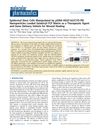Search
forLearn
5 / 9 resultslearn Thymosin Beta 4
learn Stem Cell Factor
learn sh-Polypeptide-7
learn Beta Polypeptide
Research
5 / 1000+ results
research Targeted Gene Delivery to Skin Cells In Vivo: A Comparative Study of Liposomes and Polymers as Delivery Vehicles
Nonionic liposomes are the best for delivering genes to skin cells.

research Epidermal Stem Cells Manipulated by pDNA-VEGF165/CYD-PEI Nanoparticles Loaded Gelatin/β-TCP Matrix as a Therapeutic Agent and Gene Delivery Vehicle for Wound Healing
The gelatin/β-TCP scaffold with nanoparticles improves wound healing and skin regeneration.

research Genetically-Manipulated Adult Stem Cells as Therapeutic Agents and Gene Delivery Vehicles for Wound Repair and Regeneration
Genetically-altered adult stem cells can help in wound healing and are becoming crucial in regenerative medicine and drug design.
research Gene Delivery to the Hair Follicle
Gene therapy shows promise for treating hair loss by targeting hair follicles.
research Efficient Gene Editing for Heart Disease via ELIP-Based CRISPR Delivery System
ELIP-based CRISPR delivery improves heart disease gene editing but needs more testing.
Community Join
5 / 395 resultscommunity Haircafe - TOPICAL minoxidil is an anti aging drug
Topical minoxidil may cause skin aging effects like wrinkles and dark circles, possibly due to its alcohol content, while oral finasteride is reported to make users look younger. Switching to oral minoxidil or using moisturizers might help reduce these skin issues.
community CRISPR Is Curing People Right Now. Genetic Hair Loss is Next?
CRISPR shows promise for treating hair loss by targeting specific genes. Current treatments include Minoxidil and finasteride, but CRISPR could offer a more precise solution, though it is still expensive and in early stages.
community Binding affinity of pyrilutamide!
Pyrilutamide, a nonsteroidal antiandrogen drug under development for the potential treatment of androgenic alopecia. The conversation discusses its binding affinity to the androgen receptor and the timeline for possible availability after trials are completed in the United States and China.
community Potential ( but not yet confirmed ) pp405 leak through korean media.
A peptide-based hair loss treatment, PP405, reportedly increased hair density by 62% in 90 days, but these claims are unverified and met with skepticism. Users compared PP405 to Minoxidil and Finasteride, expressing doubts about its effectiveness without more evidence.
community What to do if fin is still not working after 2.5 years
The user is experiencing increased hair loss despite using finasteride and oral minoxidil and is hesitant to switch to dutasteride due to side effects and family planning concerns. Alternatives suggested include dutasteride, microneedling, and addressing stress or nutrient deficiencies.